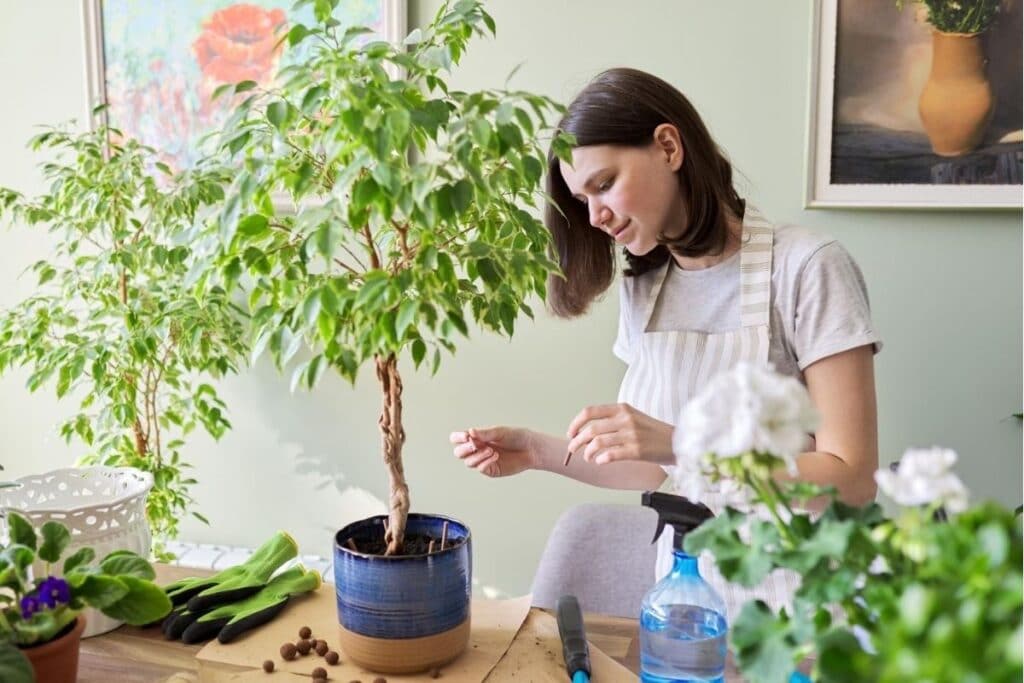What comes to mind when one hears the word fig is the tender and sweet teardrop-shaped fruit that comes from a tree of the same name. It is actually the general term for a big group of plants, many of which are grown as houseplants.
They adapt well to the indoor environment, each species with its own decorative characteristics that it is no wonder they are found in every office building and are always available in indoor plant nurseries.
Indoor figs are unique and reliable plants that hold a lot of potential in making any space greener and captivating.
What is a Ficus Tree?
Ficus (Botanical Name: Ficus benjamina) is a genus of over 800 plants that belong to the Mulberry or Moraceae family (1). Commonly referred to as fig, it became a popular group of plants thanks to the edible Mediterranean species called F. carica (2).
The ficus group is characterized by simple, often glossy ovate to lanceolate evergreen leaves. The stem and the leaves that break secrete yellowish or white latex. As they mature, long aerial roots form along the trunk and branches of the plants enabling them to thrive as epiphytes (1).
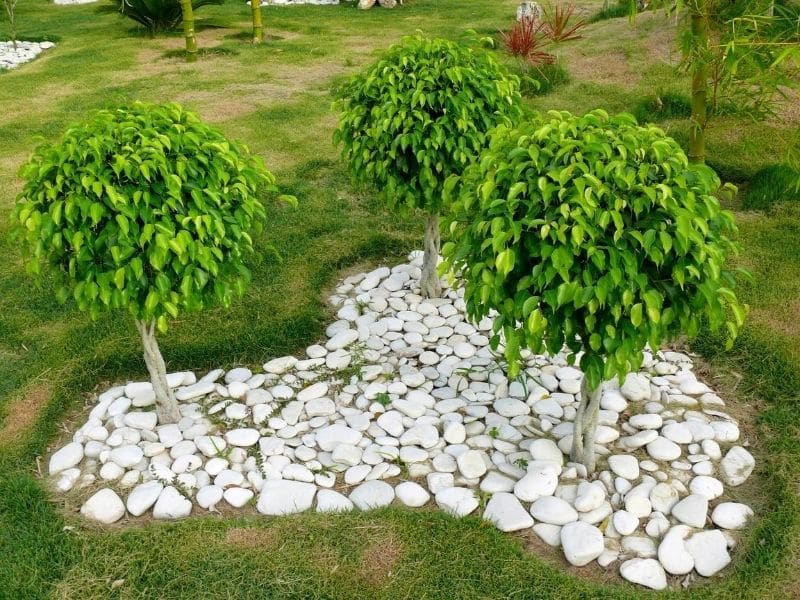
What Are the Uses of Ficus?
The sweet fruit borne on the edible fig is popularly eaten around the world and gave way to the introduction of other ficus species.
These plants naturally grow in tropical Africa and Asia and were observed to grow and survive dry indoor climates. Because of this versatility together with the attractive forms and variations in foliage of the plants, many figs became popular indoor plants too (2).
Many are grown as regular potted indoor plants like F. lyrata, F. elastic, and F. maclellandii (Banana Leaf Fig) but most ficus have the potential to be used in the traditional art of bonsai. The growing parts of ficus plants are easy to manipulate, a requirement in creating a successful ficus bonsai (1).
The growth and shape of ficus vary from one plant to another so they can add height and texture to landscapes too. Some train them as espaliers and topiaries as well as garden hedges and screens (3).
One species, F. religiosa is associated with the Buddhist religion as it was believed that Buddha achieved enlightenment after sitting for 6 years under this fig tree. Because of this, the plant is religiously celebrated around the world.
Ficus is also industrially important since it is sourced in the production of rubber. The latex produced by F. elastic or rubber tree, is collected in large quantities and in Southeast Asia, hectares of land are used as plantations of this tree (1).
How to Take Care of Ficus

Watering
The most common issue with growing indoor ficus trees is the dreaded leaf drop. For species like F. lyrata and F. elastica, this is a major concern since these plants boast beautiful broad leaves which is a waste when they all end up on the floor leaving one a bare tree.
This premature leaf drop is associated with overwatering. Most fig species are sensitive to overwatering. They only need to be irrigated when the soil is almost dried out. In cold conditions, it is important to use water that is at room temperature (2).
Ficus likes soil of lesser pH so it is best to use rainwater or boiled water. Spraying the leaves with water from time to time is also beneficial to the plant, just make sure that foliage will remain dry for the most part of the day to avoid water-borne diseases.
Growth Requirements
Ficus plants were originally found growing in tropical rainforests, basically they are tropical plants and that is why they thrive best under warm conditions and high humidity (2).
They like bright indirect or filtered light but should be kept out of direct sunlight or it will cause leaf scorch. Should they be placed under the sun, make sure that they don’t get exposed the whole day.
However, these plants can tolerate the indoor condition and are found to survive even the dry air caused by central heating and air conditioning. When placed outside during the cold season, they can withstand up to 15 degrees of frost but the leaves will drop beyond this.
It is important to identify the location inside the house where a fig plant will be permanently placed so as to avoid moving the plant frequently. Once the plant has transitioned to a certain indoor setting, moving it around may affect its health and will prolong its adaptation (4).
Pests and Diseases
Mealybugs, spider mites, aphids, and scale insects are some of the insect pests that may infest indoor figs. A few occurrences can be controlled by manually removing them on the plant surfaces as well as the unsightly leaves. If the infestation gets worse, systemic insecticides and miticide will serve as a permanent cure (1).
Figs that are exposed to prolonged wet conditions are subject to fungal diseases. They may appear as round orange to brown to black spots on the leaves (for example, fiddle leaf fig brown spots) or as uniform foliage and stem discolorations. If left untreated, this can lead to leaf fall and decay of branches.
Fungal diseases may be avoided by keeping the plants free from unwanted moisture. Air circulation can be improved by placing a fan near the plant after light misting. Infected parts should be removed and application of fungicide is important for persistent infection (1)
Keeping Figs Lush
One of the things that make figs successful indoor plants is their lush evergreen growth but this entails pruning activities to maintain their shape and health. Species like F. benjamina, F. microcarpa and F. pumila should be trimmed every 2 to 3 months to retain their natural form (3).
Figs with broader leaves will benefit from dusting once or twice a month. Wiping off with a damp cloth or sponge will help remove the dust and at the same time keep the leaves glossy. Buttermilk or neem oil will leave a F. lyrata and F. elastica with a beautiful sheen (2).
When it comes to fertilizers, figs are not very demanding but when you see the leaves looking paler than usual, it is either water is lacking or the plant needs some feeding. As long as the well-draining medium is slightly acidic and of medium fertility, they will survive.
Large plants may need an annual top-dressing wherein the top few inches of soil is removed and replaced with fresh nutrient-enhanced soil mixture. A monthly spray of foliar fertilizer will not hurt too (3).
Propagation and Repotting
One of the easiest plants to propagate, figs can be grown from seed, stem cuttings or marcots. Fig seeds are not easily found, often available in the tropics where the plant originated. Nursery growers and bonsai dealers are the ones who usually grow special fig varieties by seeds. This can take up to five years and is nowadays performed using a hydroponic system (1).
Cuttings from branches form roots easily because the plant is already capable of producing aerial roots. That is why marcotting is also an effective propagation method for figs. Once the roots have established, they can be repotted and will acclimatize in a span of a month or so.
Since figs grow roots fats, they tend to become pot-bound. Root pruning is necessary to avoid the roots from suffocation one another which can lead to the plant’s death. This can be done by gently pulling apart the roots and trimming a few relatively oversized ones. Leave the young feeder roots to help the plant recover faster.
A bigger plant needs a bigger pot to allow the roots to establish and to provide the necessary nutrients from the soil. Repotting with a light, fast-draining soil can be done every 2 to 3 years (3).
Common Problems
Studies showed that figs remove formaldehyde and other atmospheric toxins (4). However, handling them indoors must be done with caution as they produce sap that can irritate the skin and eyes. Protective gloves must be worn when removing leaves or cutting stems. These ficus houseplants should also be kept away from people with asthma who can be sensitive to the windborne particles (1).
Figs like F. benjamina grow roots so fast they can become obtrusive. When grown in fixed planters, the roots can penetrate drainage systems and clog them. Installation of a root barrier is important in this situation to prevent damage.
Top 7 Best Types of Ficus Trees To Grow
1. Creeping fig (F. pumila)
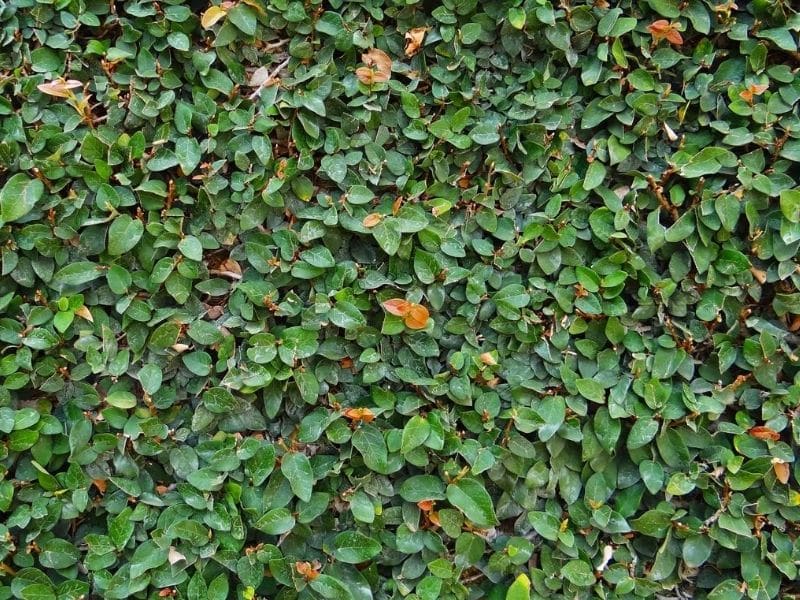
The most popular vining fig species, it produces long stems with alternating small and soft green round leaves that grow fast and vigorous. A charming indoor plant, creeping fig is also commonly used to cover concrete walls and fences.
2. Rubber tree plant (F. elastica)
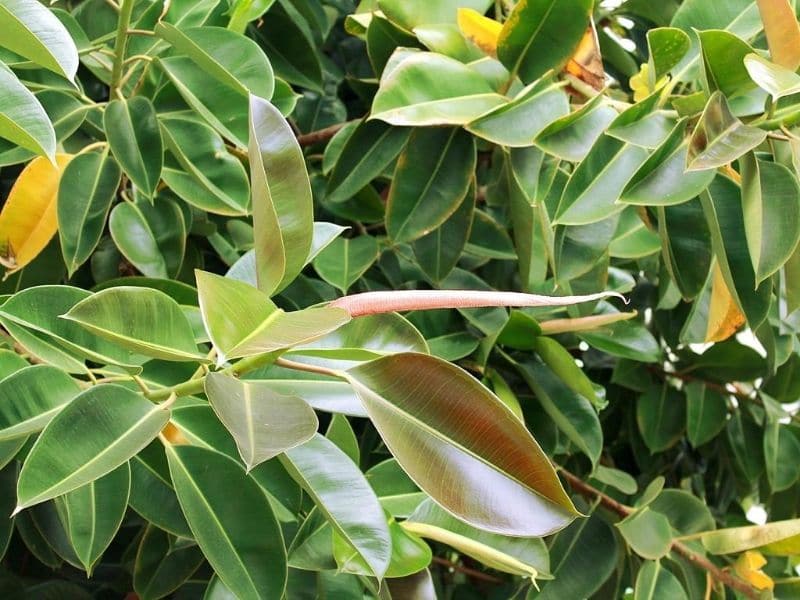
A drought-tolerant fig, this is striking with its leathery, oblong, glossy green leaves. The popular ‘Burgundy’ variety showcases black reddish foliage.
3. Weeping Fig (F. benjamina)
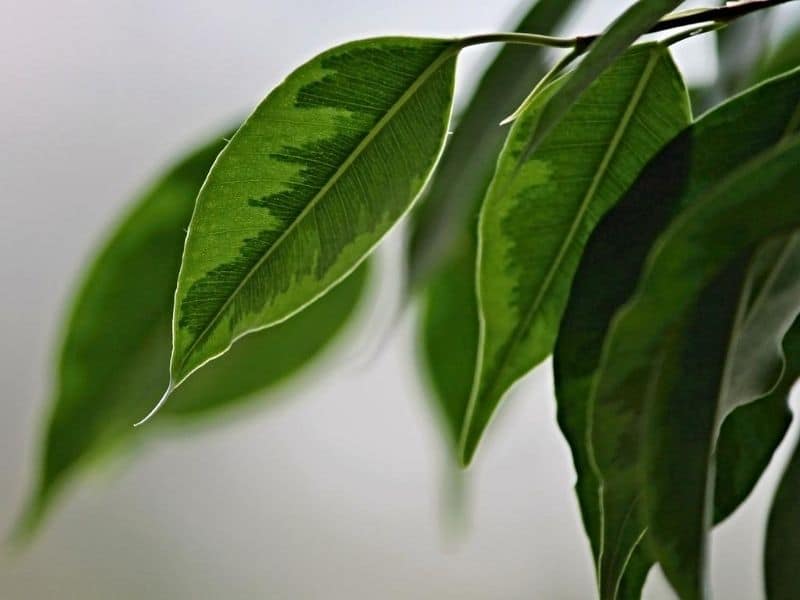
One of the most common houseplants in the US, this is characterized by the leathery green oval to egg-shaped small leaves that hang on slender twigs and stem in a slightly weeping form, hence the name. Types with white and yellow variegations are also popular.
4. Fiddle-leaf fig (F. lyrata)
This broad-leafed fig is known for its rough and leathery fiddle-shaped leaves. It is a multi-stemmed species that can reach the ceiling with the right care.
See more: Best soil for fiddle leaf fig
5. Mistletoe fig (F. deltoidea)
This shrub is one of the smaller ficus grown indoors. It has small teardrop-shaped green leaves and in between are tiny round green or yellow fruits that look like mistletoes.
6. Sacred fig (F. religiosa)
In the wild, this fig can grow as high as 30 meters. The buttressed and wide-spreading full form is one of its unique and celebrated features that it is popularly grown as a bonsai.
7. Clown fig (F. aspera)
This is often grown as a hedge plant but can make a striking potted indoor plant with its leaves speckled and striped with shades of green and white.
FAQs
What does an overwatered Ficus look like?
An overwatered Ficus may display symptoms such as yellowing leaves, wilting despite moist soil, and leaf drop. The soil becomes waterlogged, leading to root suffocation, root rot, and a decline in the overall health of the plant.
Why are all the leaves falling off my ficus?
If all the leaves are falling off your Ficus, it could be due to various factors, including overwatering, underwatering, changes in light conditions, or pests. Assess the moisture levels in the soil, adjust your watering practices, and consider environmental factors to address the issue and promote the health of your Ficus.
References
Reference list
(1) Meislik, J. “The World of Ficus Bonsai”. 2019. Friesen Press. P. 322.
(2) Vermeulen, N. “Encyclopedia of House Plants”. 1999. Taylor and Francis. P. 320.
(3) Appell, S. “Landscaping Indoors: Bringing the Garden Inside”. 2000. Brooklyn Botanic Garden. P. 111.
(4) Osterhoudt, M. “Health Benefits of Indoor Plants”. 2013. Lulu Press Inc. P. 8.
Close
*Image by Valerii_Honcharuk/depositphotos

